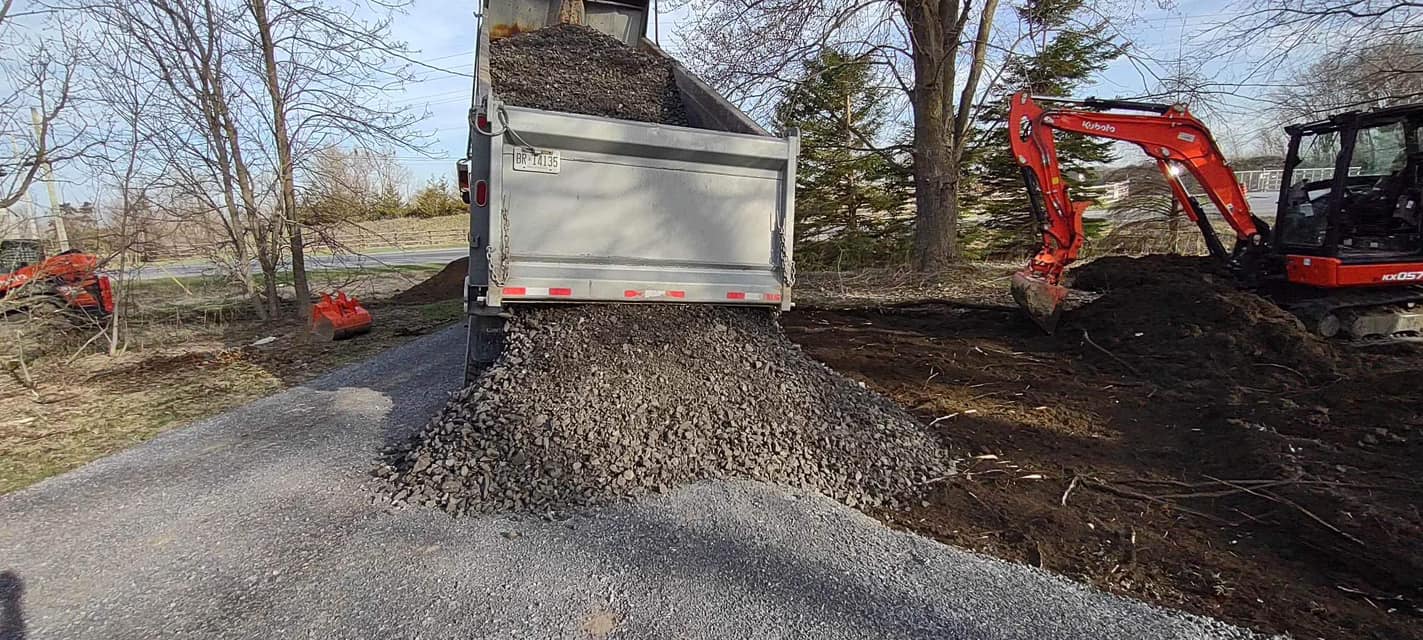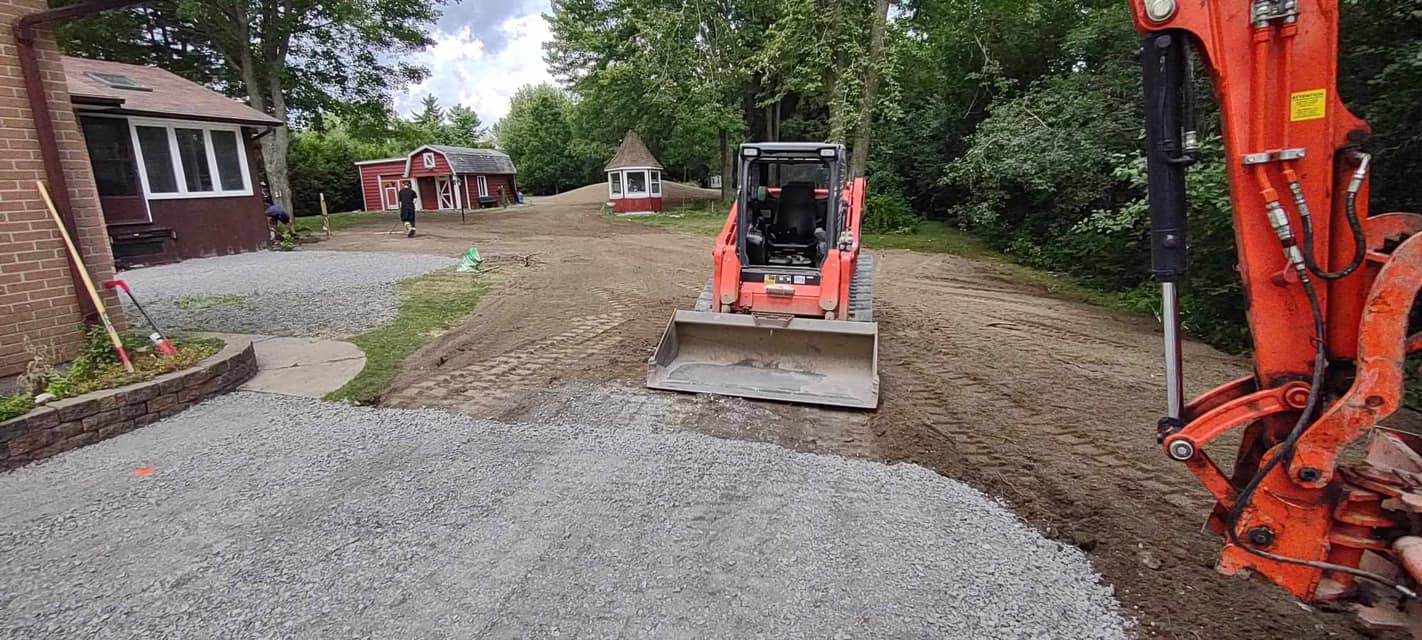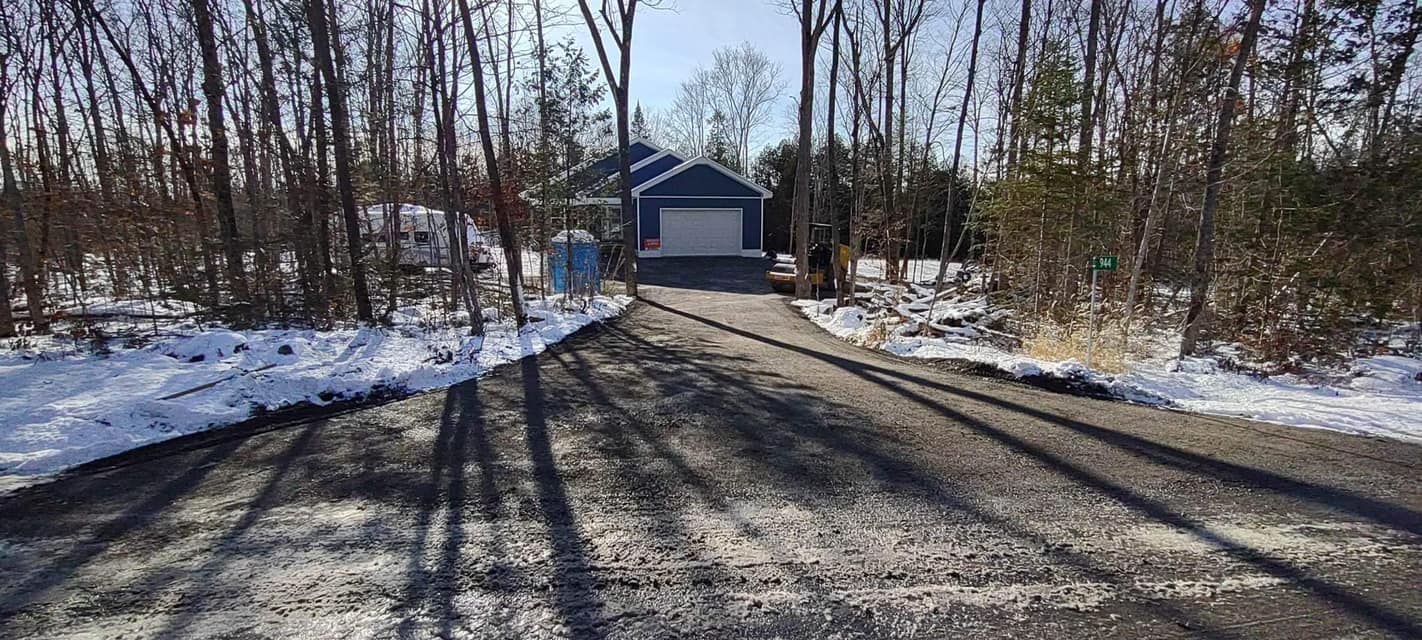When planning a new driveway or resurfacing an old one, the choice of material is one of the most important decisions you will make. Gravel remains one of the most popular options in Ontario because it is affordable, versatile, and durable enough to handle our variable climate. However, not all gravel is created equal. Knowing the strengths and weaknesses of different driveway gravel types helps you choose the right material for your property and avoid costly mistakes.
At M. Riddle Excavating, we regularly install and maintain driveways across Kingston, Napanee, Frontenac, and Rideau Lakes. Homeowners often ask about the differences between 3-quarter crush, A-gravel, and recycled asphalt. Each has unique characteristics that affect appearance, cost, maintenance, and long-term performance.
What Makes a Good Driveway Gravel Type?
A good driveway material should provide stability, handle vehicle traffic without rutting, and allow water to drain away efficiently. In Eastern Ontario, where winters bring freeze-thaw cycles and summers can be both hot and rainy, these qualities become even more important.
The best driveways are usually built in layers. A strong base layer resists shifting, while a surface layer offers a smoother finish. Choosing the right combination of driveway gravel types ensures your driveway can withstand years of use without constant repairs.

3-Quarter Crush Gravel: The Workhorse
3-quarter crush is one of the most reliable driveway gravel types. It consists of angular crushed stone measuring about three-quarters of an inch in size. Because the pieces are sharp-edged rather than rounded, they lock together tightly when compacted. This interlocking quality creates a stable surface that resists movement under vehicle weight.
In driveway construction, 3-quarter crush is often used as the base layer. Its density and strength provide the foundation needed to support the rest of the driveway. Without a strong base, even the best surface material will eventually shift or settle unevenly.
Another advantage of 3-quarter crush is drainage. The angular stones create small gaps that allow water to flow through rather than pooling on the surface. This reduces frost heave in winter and helps maintain driveway stability year-round.
Maintenance is straightforward. With proper grading and crowning, 3-quarter crush can last for years with minimal upkeep. It may require occasional top-ups if washouts occur, but overall it is one of the most dependable driveway gravel types available.
A-Gravel: The Versatile Choice
A-gravel is another popular option in Ontario. Unlike 3-quarter crush, which is uniform in size, A-gravel is a blend of sand, stone, and fines. The mix of particle sizes allows the material to compact well, forming a dense and durable surface.
Because of its composition, A-gravel is often used as a finishing layer for driveways. It creates a smoother surface compared to coarser aggregates while still allowing some drainage. Many rural homeowners choose A-gravel because it balances performance, cost, and availability.
One drawback of A-gravel is dust. During dry summer months, the fine particles can rise into the air under vehicle traffic. While this does not affect the structural strength of the driveway, it can be a nuisance and may require dust control treatments.
Still, A-gravel remains one of the most cost-effective driveway gravel types, especially for rural and cottage properties. When paired with a strong base of 3-quarter crush, it delivers a driveway that can handle both light and heavy use.
Recycled Asphalt: The Sustainable Alternative
Recycled asphalt, or reclaimed asphalt pavement (RAP), is gaining popularity as a driveway surface. Made from ground-up asphalt collected during road resurfacing projects, this material offers several advantages over traditional gravel.
When compacted, recycled asphalt binds together, forming a semi-solid surface that looks and feels more like pavement than loose gravel. In hot summer weather, the asphalt can even soften slightly, further binding the surface and reducing dust.
One of the biggest benefits is sustainability. By reusing old asphalt, recycled asphalt reduces waste and lessens demand for new aggregate. It is also typically more affordable than fresh asphalt, making it attractive for homeowners who want a durable surface without the cost of full paving.
In terms of maintenance, recycled asphalt requires less frequent grading compared to traditional gravel. It resists washouts and dust, though occasional top-ups may still be needed. For homeowners who want a cleaner finish than gravel but cannot justify paving, recycled asphalt is one of the most practical driveway gravel types available.
Seasonal Considerations in Eastern Ontario
Driveways in Kingston, Napanee, and Rideau Lakes face unique seasonal stresses. Spring brings frost heaves and heavy runoff, summer brings dust and washouts from sudden storms, and winter plowing can displace surface gravel.
3-quarter crush handles freeze-thaw cycles best because of its stability and drainage. A-gravel can struggle with dust in the summer but performs well overall when maintained. Recycled asphalt offers the least dust and best compaction but can soften in extreme summer heat.
Planning your driveway with these seasonal factors in mind helps reduce long-term maintenance. Proper grading and crowning are essential for controlling water and extending surface life. The same principles apply to driveways.
Cost and Longevity Comparison
Cost often plays a major role in choosing driveway gravel types. Generally, A-gravel is the most affordable, followed by 3-quarter crush, with recycled asphalt sometimes costing slightly more depending on availability. However, initial cost is only part of the equation.
3-quarter crush has the longest lifespan as a base layer, often lasting decades if properly installed. A-gravel may require more frequent surface maintenance but remains budget-friendly. Recycled asphalt offers a balance between cost and performance, with reduced maintenance and a more finished appearance.
Factoring in longevity and upkeep, many homeowners find that investing in a strong base of 3-quarter crush topped with A-gravel or recycled asphalt provides the best long-term value.
Environmental Impact and Sourcing
Sustainability is another consideration when choosing driveway gravel types. Recycled asphalt stands out as the most eco-friendly option, repurposing material that would otherwise go to waste. Both A-gravel and 3-quarter crush are derived from quarrying operations. According to the Ontario Stone, Sand & Gravel Association, producers supply the vast majority of the approximately 164 million tonnes of aggregate consumed each year in Ontario – including sand, gravel, and crushed stone – all created through quarrying and processing activities.
Working with a local contractor ensures that materials are sourced responsibly and transported efficiently. At M. Riddle Excavating, we prioritize local sourcing wherever possible, reducing environmental impact while supporting the regional economy.
Final Thoughts
Driveways are more than just practical access points – they are an investment in the value and usability of your property. Our previous projects demonstrate how choosing the right material, whether 3-quarter crush, A-gravel, or recycled asphalt, creates long-lasting results that balance cost, durability, and appearance.
The right driveway gravel type depends on your property’s needs, traffic levels, and budget. For some homeowners, a simple A-gravel driveway is the best solution. For others, a combination of 3-quarter crush and recycled asphalt provides long-lasting results with minimal dust.
At M. Riddle Excavating, we help homeowners across Eastern Ontario select and install the right material for their driveway. If you are planning a new build or resurfacing project, you can contact our team to discuss the best options for your property.
With the right materials and proper installation, your driveway will provide safe, reliable access for years to come.


